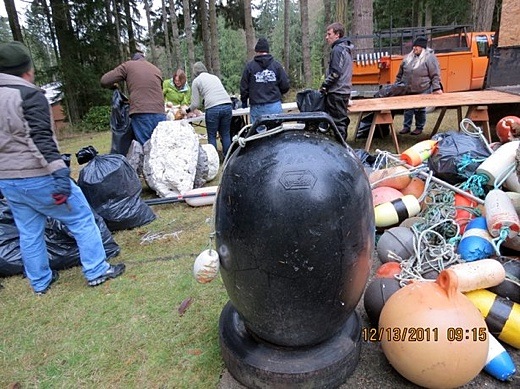 Image above: Debris from Japanese tsunami reached Washington state in December 2011. From (http://www.brucesussman.com/earthquakes-volcanoes/japanese-tsunami-debris-washington-us-west-coast/).
Image above: Debris from Japanese tsunami reached Washington state in December 2011. From (http://www.brucesussman.com/earthquakes-volcanoes/japanese-tsunami-debris-washington-us-west-coast/).
At this very moment, up to 25 million tons of debris--occupying an area roughly the size of California--is a on a collision course for the North American west coast.
The floating wreckage, often called flotsam, is a result of the massively destructive, 9.0-magnitude earthquake that struck just off the coast of Japan last March.
Peninsula College oceanographers Curtis Ebbesmeyer and Jim Ingraham told the Huffington Post that the wreckage could include virtually anything that floats-- portions of houses, boats, ships, furniture, cars and even human remains (athletic shoes can act as flotation devices).
"You're going to have the flotsam go four places," Ebbesmeyer explained to the the American Foreign Press. "Some is going to sink, which might be a quarter; some is going to come to North America, which might be a quarter; some is going to come around back to Japan, which might be a quarter, about six years later; some is going to go into the garbage patch, which might be a quarter roughly."
The first pieces of flotsam began to hit the United States in late 2011; however, a great deal more will likely wash ashore over the course of the next year two years--with the majority starting to land next winter.
The Environmental Protection Agency has begun coordinating with the U.S. Coast Guard on an extensive clean-up effort, but the agency admits they're still largely in the dark about exactly what the scale of that effort will be.
"We don't know how much is floating, we don't know how much is buoyant, how much is under the surface, how much has broken up," EPA Regional Director Jared Blumenfeld told ABC-7 News, "but we do know there is a huge amount of it and stuff that you don't normally find. Cars, houses, telephone booths, I mean you name it."
A historical precedent makes it difficult to predict the ultimate landing place of waterborne debris. The San Jose Mercury News reports:
[National Oceanic and Atmospheric Administration Pacific Islands Director Kris] McElwee noted that after other major disasters, including Hurricane Katrina in 2005 and the Indian Ocean tsunami in 2004, massive amounts of material that washed out to sea did not turn up on beaches in other countries. Instead, the flotsam caused problems near the beaches where it originated, creating hazards for ships and disrupting commercial fishing.
Officials have noted, even though the tsunami created a major nuclear threat in Japan, there's very little risk of any radioactive material hitting American or Canadian shores.
Starting last year, a handful of organizations have begun taking researchers studying ocean currents and nautical plastic accumulation as well as tourists interested in seeing the floating aftermath of the Japanese disaster on firsthand trips through the Pacific gyre, where much of the debris has accumulated. "For me it's interesting to see that there is debris from the ocean coming from events like tsunami--things that you can't control--and things that you can control as well," cruise participant Valerie Lecoeur told National Geographic
Check out this computer simulation from the International Pacific Research Center showing how the debris will likely travel over time:
Video above: From (http://blogs.kqed.org/newsfix/2011/07/05/japanese-tsunami-debris-california-animation/). See also: Ea O Ka Aina: Tsunami Debris to reach Hawaii 4/7/11 Ea O Ka Aina: Fukushima debris nears Midway 10/13/11 Ea O Ka Aina: Japanese tsunami debris 12/4/11 .
No comments :
Post a Comment